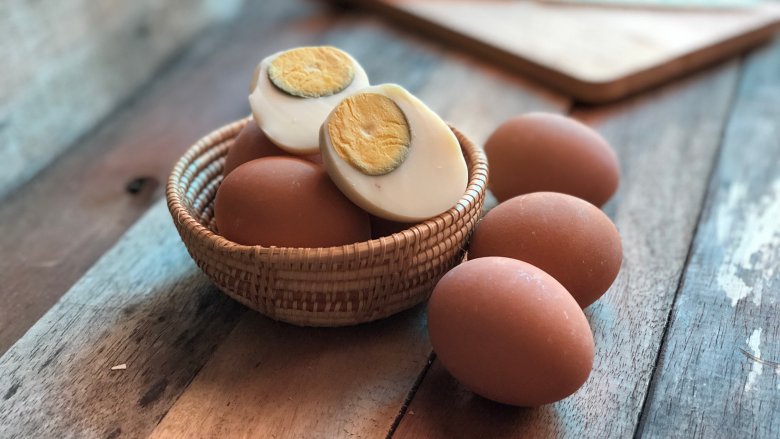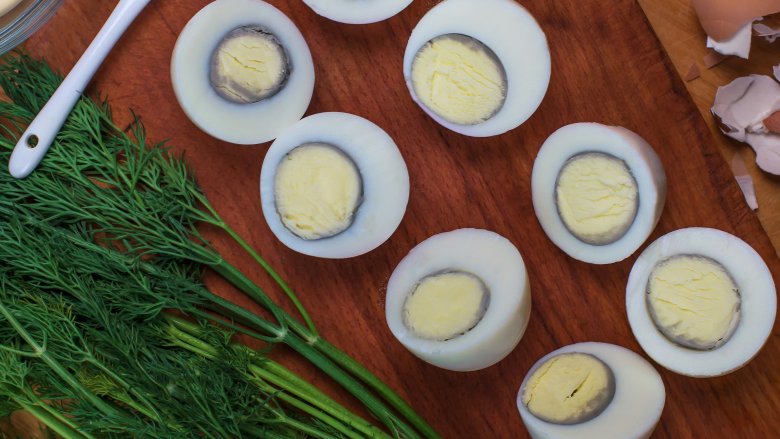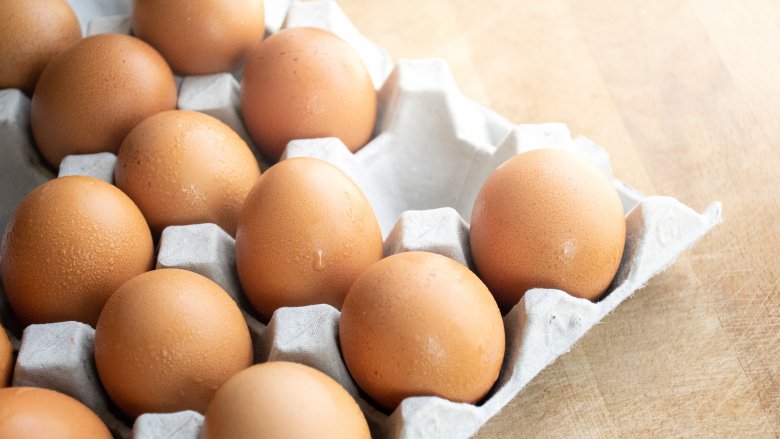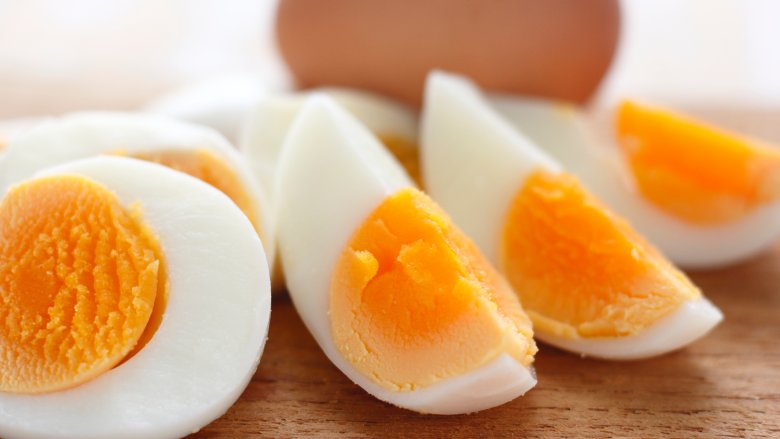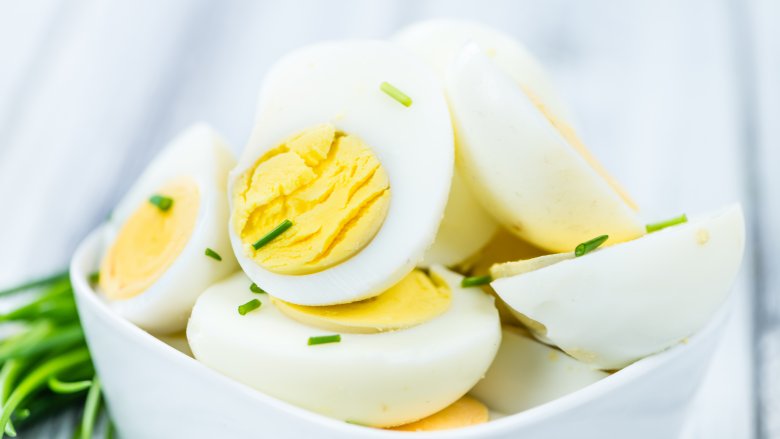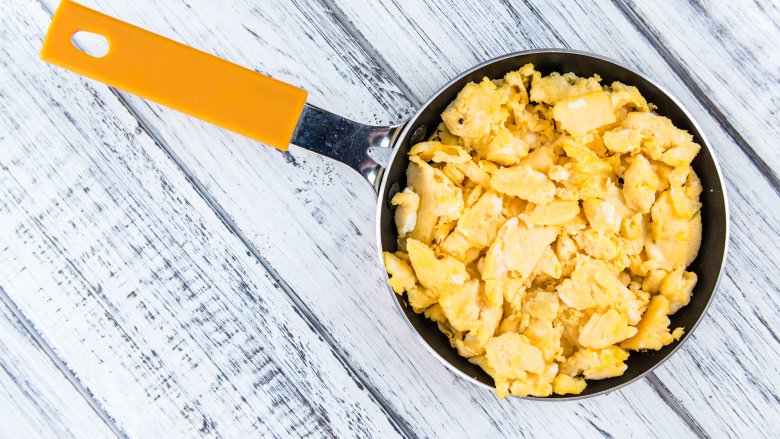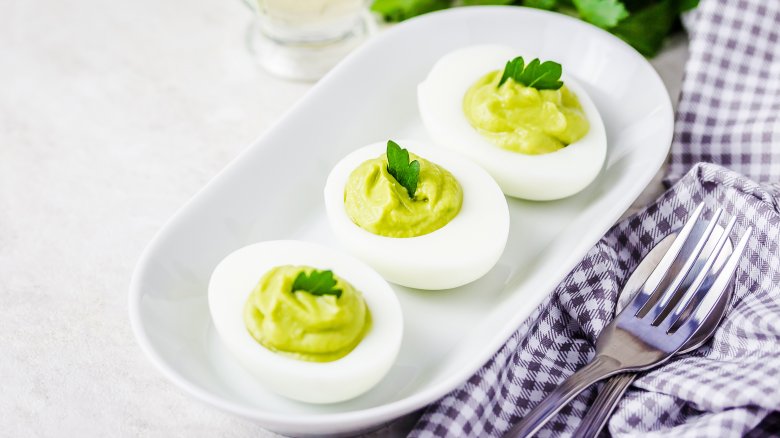How To Stop Your Cooked Eggs From Turning Green
It's a foodie's ultimate Instagram faux pas: A hard-boiled egg with a grayish-green ring around the yolk. How can you possibly top your salad with such a monstrosity? How can you brag all over social media about your otherwise gorgeous meal with this glaring fail perched atop? Step away from your phone, and let's figure out why you suffered this particular egg mishap in the first place.
There are a lot of questions to be answered: What actually makes that unsightly ring around the yolk appear? Is it safe to eat? Does it taste bad? Is there a way to mitigate that smell? And most importantly, how do you prevent it so you can resume your regularly scheduled program of drool-worthy food photos? We'll figure all that out. And as long as we're talking about green eggs, let's not forget that scrambled eggs have the propensity to morph into a would-be Dr. Seuss meal if you're not careful. We'll let you in on how to avoid that embarrassing brunch fail, too.
What causes it?
There's a very easy unscientific answer to this question, and the answer is you. You are causing the discoloration around the yolk by overcooking your hard-boiled eggs, and now, not only do you have the dreaded green or gray ring to contend with, but the yolk is also going to be chalky and dry.
But if it makes you feel better to blame your egg fail on science, we can help you out. The scientific explanation is that a chemical reaction in the egg occurs when it's cooked too long, resulting in the green ring around the yolk. Elisa Maloberti, director of product marketing at the American Egg Board, explained to Chowhound, "The discoloration is due to the formation of ferrous sulfide where the yolk and white meet. It's formed when iron from the yolk reacts with hydrogen sulfide from the white." And the more overcooked the egg is, the darker that discoloration will be.
Don't worry though — as unsightly as the green ring might be, it is perfectly safe to eat (provided you like dry, crumbly yolks).
Which eggs are the worst offenders?
If you're prone to overcooking your hard-boiled eggs — and you'll know this if your yolks are discolored every time — then it might be worth seeking out the freshest ones you can find.
Yes, even though we've always been told that old eggs are easier to peel, Cook's Illustrated has determined that fresh eggs are key to avoiding the green ring when hard-boiling (and they promise they won't be a nightmare to peel, but more on that in a minute). This has to do with the alkaline levels in the eggs — fresh eggs have only a slightly alkaline white, and as eggs get older, that alkaline level increases. The higher the alkaline level, the more quickly the chemical reaction between the sulfur and the iron in the egg will occur. So, the longer it takes for that reaction to occur, the less chance there is that your yolk will be discolored. Score one for fresh eggs.
No matter what kind of egg you're using though, if you crack one open and see a green tinge to the whites, abort your mission. Discoloration in raw eggs means bacteria is present and indicates spoilage.
How to avoid the dreaded ring
At this point you've probably guessed that the key to avoiding the ring around the yolk is to not overcook the egg. According to the American Egg Board, this tried-and-true method will get you perfectly cooked hard-boiled eggs, sans the green ring, each and every time:
Use a saucepan that will hold the eggs in a single layer, and add enough cold water to cover them by about 1 inch. Heat the pan over high heat until the water is just boiling, then immediately remove from the burner, cover the pan, and let the eggs sit to finish cooking (medium eggs will take about nine minutes, large eggs about 12 minutes). If you're serving them warm, simply drain and peel. Otherwise, run cold water over the eggs until they are completely cool. This is an important step as it will stop the cooking process, and prevent the green ring from forming.
As an added bonus, this cooking method will also ensure that you avoid the stinky sulfur "rotten egg" smell. Win, win.
Or try the steam method
Remember how Cook's Illustrated recommended using fresh eggs for hard-boiling, with a promise of both easy peeling and no green ring around the yolk, even though that goes against everything we've been taught about how to make easy-to-peel eggs? Well, the results of their exhaustive research don't lie, and they did indeed come up with a cooking method that delivers on those promises, old eggs not required.
It's all about the steam: Place a steamer basket full of eggs into a pot containing 1 inch of boiling water, cover, and cook for about 13 minutes. When done, plunge the eggs into an ice bath for at least 15 minutes, or until completely cooled.
At this point, no matter how fresh your eggs are, the shells should practically fall off, leaving behind a perfectly smooth white surface. And of course, because you haven't overcooked them, there will be no discoloration around the yolk either.
What about scrambled eggs?
Though we don't hear as much about it, it turns out that scrambled eggs can turn green, too. And unless it's St. Patrick's Day or you're hosting a Dr. Seuss-inspired brunch, green eggs probably aren't the outcome you're hoping for.
Similar to the way a green ring forms around hard-boiled yolks due to a reaction between the iron and hydrogen sulfide in the egg, scrambled eggs can also experience a color change. According to the American Egg Board, you might see the harmless green tinge appear when you're cooking in a cast iron skillet, and that's thanks to the iron in the pan reacting with the sulfur in the egg whites.
This one's an easy fix though: Simply don't use cast iron to scramble your eggs — utilize stainless steel or nonstick pans to avoid any unappetizing hues. And if you're still worried about embarrassing yourself at brunch, grab a lemon. Since lemon juice is a chemical reaction neutralizer, a small amount mixed into your eggs can prevent a color change. You should only need about 1/8 teaspoon for every 12 eggs.
What to do with an egg fail
As we now know, green rings around the yolks and green scrambled eggs are harmless and perfectly safe to eat, but you might not want to serve them to guests. So rather than dump a dozen eggs in the garbage, what can you do to salvage an egg fail?
Unfortunately, if it's green scrambled eggs you're left with, there's not much you can do. Maybe cover them with a few handfuls of cheese? Everybody loves cheese. And definitely pour a few extra bloody marys.
Discolored hard-boiled yolks are a little easier to disguise — just make deviled eggs. Throw an avocado into the mix and use that green tint to your advantage. Simply add it into your usual recipe, or go with a guacamole-inspired twist and along with mayo and avocado, add some chopped cilantro, lime juice, chopped jalapeño, and minced garlic or onion. Nobody will suspect a thing, and guacamole deviled eggs are definitely Instagram-worthy.
